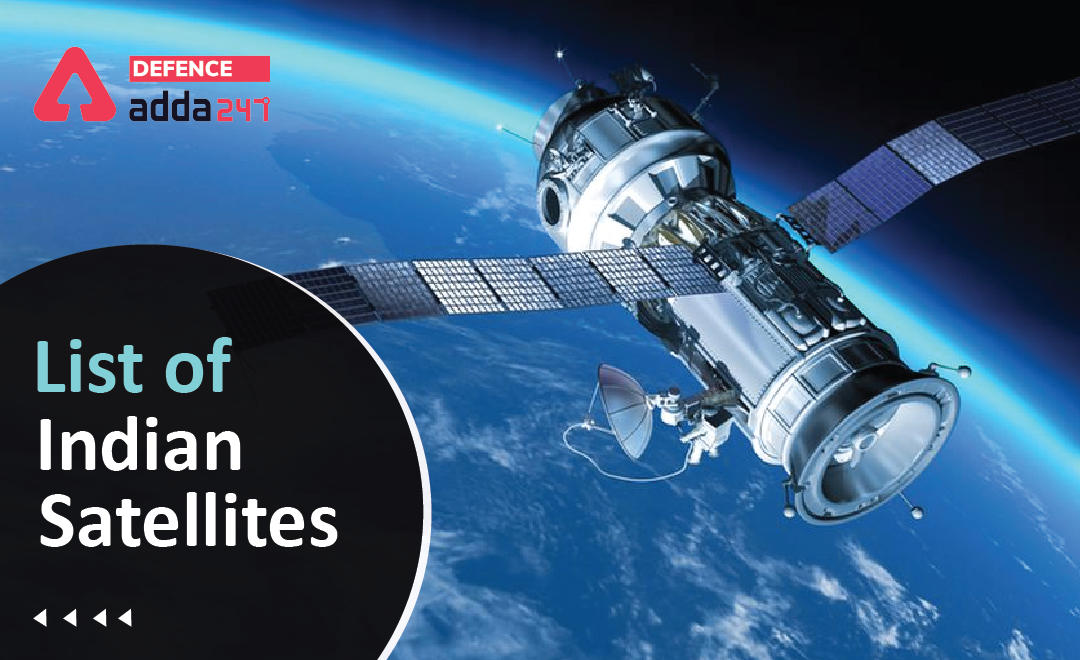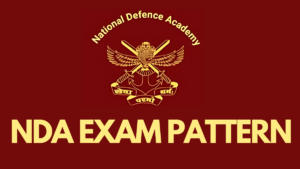List of Indian Satellites
As many of you are aware, numerous Defense Exams are currently underway. If you’re gearing up for these tests, you understand the significance of General Awareness as a frequently posed subject. Enhancing your General Knowledge section not only allows you to secure more points but also affords you more time for tackling other sections. To aid you in this endeavor, we’ve compiled a roster of significant satellites launched by India. This compilation aims to provide you with an understanding of the remarkable work accomplished by ISRO. Prior to delving into the satellite list, let’s take a moment to get acquainted with a concise overview of satellites and the Indian Space Research Organization (ISRO).
What is a Satellite?
A satellite is an object that orbits around another object in space. There are two types of satellites: natural satellites and artificial satellites.
- Natural satellites are objects that formed from the same material as the object they orbit around. For example, the moon is a natural satellite of Earth.
- Artificial satellites are objects that are launched into space by humans. Artificial satellites can be used for a variety of purposes, such as telecommunications, meteorology, remote sensing, and scientific research.
There are many Government Organisations in the world that launch artificial satellites. One such organization is ISRO.
What is ISRO?
Indian Space Research Organization, also known as ISRO is a space agency of Government of India which has its Headquarters in Bengaluru. It was established by renowned scientist Vikram Sarabhai in 1962. This agency is mainly involved in Research and Development activities related to Space Application including launching Artificial Satellites.
As you can see there are various types of satellites like Communication, Scientific, Experimental, Navigation, etc. Now without further ado, let us begin with the list of all the Satellites launched by India.
List of Indian Satellites [1975-2022]
| Launch year | Satellite | Importance |
| 1975 | Aryabhatta |
|
| 1979 | Bhaskara Sega-I |
|
| Rohini Technology Payload | The First Indian launch vehicle Failed to achieve orbit. | |
| 1980 | Rohini RS-1 |
|
| 1981 | Rohini RS-D1 |
|
| Apple |
|
|
| Bhaskara-II |
|
|
| 1982 | INSAT-1A |
|
| 1983 | Rohini RS-D2 | Identical to RS-D1. |
| INSAT-1B |
|
|
| 1987 | SROSS-1 |
|
| 1988 | IRS-1A |
|
| SROSS-2 | Carried remote sensing payload of the German space agency and gamma-ray astronomy payload. | |
| INSAT-1C | Same as INSAT-1A. | |
| 1990 | INSAT-1D | Identical to INSAT-1A. |
| 1991 | IRS-1B | Improved version of IRS-1A. |
| 1992 | INSAT-2DT | Launched as Arabsat 1C. |
| SROSS-C | It carried gamma-ray astronomy and aeronomy payload. | |
| INSAT-2A | The first satellite in the second-generation Indian-built INSAT-2 series. | |
| 1993 | INSAT-2B | The second satellite in the INSAT-2 series. |
| IRS-1E | Earth observation satellite. Failed to achieve orbit. | |
| 1994 | SROSS-C2 | Identical to SROSS-C. |
| IRS-P2 | Launched by the second developmental flight of PSLV. | |
| 1995 | INSAT-2C | It has capabilities such as mobile satellite service, business communication and television outreach beyond Indian boundaries. |
| IRS-1C | Launched from Baikonur Cosmodrome. | |
| 1996 | IRS-P3 |
|
| 1997 | INSAT-2D | Same as INSAT-2C. |
| IRS-1D | Same as IRS-1C. | |
| 1999 | INSAT-2E | Multipurpose communication and meteorological satellite. |
| OceanSat-1 |
|
|
| 2000 | INSAT-3B | Multipurpose communication satellite. |
| 2001 | GSAT-1 |
|
| TES |
|
|
| 2002 | INSAT-3C | Augmented the INSAT capacity for communication and broadcasting |
| Kalpana-1 |
|
|
| 2003 | INSAT-3A | Multipurpose communication satellite, similar to INSAT-2E and Kalpana-1. |
| GSAT-2 |
|
|
| INSAT-3E | Communication satellite to augment the existing INSAT System. | |
| ResourceSat-1 | Intended to supplement and replace IRS-1C and IRS-1D. | |
| 2004 | EduSAT | India’s first exclusive educational satellite. |
| 2005 | CartoSat-1 |
|
| HamSat |
|
|
| INSAT-4A | Advanced satellite for direct-to-home television broadcasting services. | |
| 2006 | INSAT-4C | Geosynchronous communications satellite. Failed to achieve orbit. |
| 2007 | CartoSat-2 |
|
| SRE-1 | An experimental satellite that was launched as a co-passenger with CARTOSAT-2. | |
| INSAT-4B | Identical to INSAT-4A. | |
| INSAT-4CR | Identical to INSAT-4C. | |
| 2008 | CartoSat-2A | Identical to CARTOSAT-2. |
| IMS-1 | Low-cost microsatellite imaging mission. Launched as co-passenger with CARTOSAT-2A. | |
| Chandrayaan-1 | India’s first unmanned lunar probe. | |
| 2009 | RISAT-2 | Radar imaging satellite. Launched as a co-passenger with ANUSAT. |
| AnuSat-1 | Research micro-satellite. It has since been retired. | |
| OceanSat-2 | Continues mission of OceanSat-1. | |
| 2010 | GSAT-4 | Communications satellite with technology demonstrator features. Failed to achieve orbit. |
| CartoSat-2B | Identical to CartoSat-2A. | |
| StudSat | India’s first pico-satellite (weighing less than 1 kg). | |
| GSAT-5P | C-band communication satellite. Failed to achieve the mission. | |
| 2011 | ResourceSat-2 | Identical to ResourceSat-1. |
| YouthSat | Indo-Russian stellar and atmospheric mini-satellite. | |
| GSAT-8 or INSAT-4G | Communications Satellite | |
| GSAT-12 | Augmented the capacity of the INSAT system for various communication services. | |
| Megha-Tropiques | Jointly developed by ISRO and the French CNES. | |
| Jugnu | Nano-satellite developed by IIT Kanpur. | |
| SRMSat | Nano-satellite developed by SRM Institute of Science and Technology. | |
| 2012 | RISAT-1 | India’s first indigenous all-weather Radar Imaging Satellite. |
| GSAT-10 | India’s advanced communication satellite. | |
| 2013 | SARAL | Joint Indo-French satellite mission for oceanographic studies. |
| IRNSS-1A | The first of seven satellites in the IRNSS navigational system. | |
| INSAT-3D | It is a meteorological Satellite with advanced weather monitoring payloads. | |
| GSAT-7 | It is the advanced multi-band communication satellite dedicated to military use. | |
| Mars Orbiter Mission (MOM) or Mangalyaan-1 | India’s first Mars orbiter. | |
| 2014 | GSAT-14 | Intended to replace GSAT-3, and to augment the in-orbit capacity of Extended C and Ku-band transponders. |
| IRNSS-1B | It is the second of seven satellites in the IRNSS system. | |
| IRNSS-1C | It is the third satellite in the IRNSS. | |
| GSAT-16 | It has the highest number of transponders in a single satellite at that time (48 transponders). | |
| 2015 | IRNSS-1D | It is the fourth satellite in the IRNSS. |
| GSAT-6 | Communication satellite that marks the success of indigenously developed upper stage cryogenic engine. | |
| Astrosat | India’s first dedicated multi-wavelength space observatory. | |
| GSAT-15 | Communications satellite. | |
| 2016 | IRNSS-1E | It is the fifth satellite in the IRNSS. |
| IRNSS-1F | It is the sixth satellite in the IRNSS. | |
| IRNSS-1G | It is the seventh satellite in the IRNSS. | |
| Cartosat-2C | Identical to CARTOSAT-2,2A and 2B. | |
| SathyabamaSat | A micro-satellite designed and built by Sathyabama University, Chennai. | |
| Swayam-1 | A 1-U pico-satellite designed and built by the students of College of Engineering, Pune. | |
| INSAT-3DR | An advanced meteorological satellite | |
| Pratham | A mini-satellite built by students and researchers at IIT, Mumbai. | |
| PISat | A micro-satellite designed and built by the students of PES Institute of Technology, Bengaluru. | |
| ScatSat-1 | Miniature satellite to provide weather forecasting, cyclone prediction, and tracking services to India. | |
| GSAT-18 | The heaviest satellite owned by India at the time of its launch. | |
| ResourceSat-2A | Identical to Resourcesat-1 and Resourcesat-2. | |
| 2017 | CartoSat-2D | ISRO holds the world record for launching the highest number of satellites by a single launch vehicle. |
| INS-1A | One of 2 nano-satellites designed and manufactured by ISRO, as part of the constellation of 104 satellites launched in a single go. | |
| INS-1B | One of 2 nano-satellites designed and manufactured by ISRO, as part of the constellation of 104 satellites launched in a single go. | |
| South Asia Satellite | It is offered by India as a diplomatic initiative to its neighbouring countries (SAARC region) for communication, remote sensing, resource mapping and disaster management applications. | |
| GSAT-19 | It is the heaviest rocket (and the heaviest satellite) to be launched by ISRO from Indian soil. | |
| NIUSat | It is built by the students of Noorul Islam University, Kanyakumari. | |
| CartoSat-2E | 7th satellite in the Cartosat series to be built by ISRO. | |
| GSAT-17 | India’s 18th communication (and to date, its heaviest) satellite | |
| IRNSS-1H | First satellite to be co-designed and built-in collaboration with private sector assistance. Failed to achieve orbit. | |
| 2018 | CartoSat-2F | 6th satellite in the Cartosat series to be built by ISRO. |
| MicroSat-TD | It is a technology demonstrator and the forerunner for future satellites in this series. | |
| INS-1C | Third satellite in the Indian Nanosatellite series. It will carry MMX-TD Payload from SAC. | |
| GSAT-6A | A high power S-band communication satellite. It will also provide a platform for developing technologies. | |
| IRNSS-II | Eighth satellite of IRNSS. | |
| GSAT-29 | High-throughput Communication Satellite | |
| HySIS | Hyperspectral imaging services for agriculture, forestry, resource mapping, geographical assessment and military applications. | |
| ExseedSat-1 | India’s first privately funded and built satellite. | |
| GSAT-11 | Heaviest Indian spacecraft in orbit to date. | |
| GSAT-7A | Services for IAF and Indian Army. | |
| 2019 | Microsat-R | Suspected to have been destroyed in the 2019 Indian anti-satellite missile test. |
| PS4 Stage attached with KalamSAT-V2 | Used PSLV’s 4th stage as an orbital platform. | |
| GSAT-31 | Replacement of the ageing INSAT-4CR. | |
| EMISAT | Electromagnetic intelligence to track any enemy radars for IAF. | |
| PS4 Stage attached with ExseedSat-2, AMSAT, ARIS and AIS payloads | Utilization of the fourth stage directly as a satellite for experiments. | |
| RISAT-2B | Successor to old RISAT-2. | |
| Orbiter of Chandrayaan-2 | India’s second lunar exploration mission. | |
| Cartosat-3 | One of the optical satellites with the highest resolutions in the world. | |
| RISAT-2BR1 | Improved resolution of 0.35 metres. | |
| 2020 | GSAT-30 | Replacement of INSAT-4A. |
| EOS-01 | Space-based synthetic aperture imaging radar. | |
| CMS-01 | Extended C-band coverage for mainland India, Lakshadweep and Andaman & Nicobar Islands. | |
| 2021 | Sindhu Netra | Earth observation satellite used by Indian Navy for surveillance over the Indian Ocean. |
| SDSat | This Nanosatellite was developed by Space Kidz India to study radiations. It carried 25,000 names and a copy of Bhagavad Gita into space. | |
| JITSat | Developed by JIT as part of UNITYSat constellation. | |
| GHRCESat | Developed by GHRCE as part of UNITYSat constellation. | |
| Sri Shakthi Sat | Developed by SIET as part of UNITYSat constellation. | |
| EOS-03 | India’s first real-time Earth observation satellite and first satellite of the GISAT constellation. | |
| Upcoming Satellites | ||
| 2022 | RISAT-1A | Radar imaging satellite to facilitate high-quality images and additional security to Indian borders. |
| OCEANSAT-3 | Earth observation satellite for oceanographic and atmospheric studies. | |
| GSAT-20 | Communication satellite to add data transmission capacity required by Smart Cities Mission of India. | |
| GISAT-2 | Multispectral and hyperspectral Earth-imaging satellite. | |
| Aditya-L1 | Solar coronal observation spacecraft. | |
| GSAT-32 | Communications satellite. | |
| TDS-01 | A technology demonstrator for TWTA and atomic clock. | |
| SPADEX x 2 | Demonstration of rendezvous space docking and berthing of spacecraft. | |
| GSAT-7R | Military communications satellite. | |
| DRSS-1 | Communications satellite comprising two satellites in the initial stage– CMS-04 and IDRSS-2 in GEO. | |
| DRSS-2 | ||
| X-ray Polarimeter Satellite | Space observatory to study polarization of cosmic X-rays. | |
| INSAT 3DS | Military communications satellite. | |
| 2022-23 | GSAT-7C | Military communications satellite. |
| AstroSat-2 | It is a space telescope and successor of AstroSat-1. | |
| 2023 | NISAR | A joint mission between ISRO and NASA is a dual-frequency synthetic aperture on an Earth observation satellite. |
| 2024 | Lunar Polar Exploration Mission | Joint lunar exploration mission between ISRO and JAXA. |
| 2024-25 | Mangalyaan-2 | India’s second Mars exploration mission. |
| 2025 | DISHA | Twin aeronomy satellite mission. |
| 2024-26 | Shukrayaan-1 | Venus exploration satellite. |
For more such interesting information, stay tuned with DefenceAdda.
Check: MPSC Rajyaseva Prelims Exam Result 2022
Check: MPSC Rajyaseva Mains Notification 2022



 Important Topics to Score 300+ in NDA GA...
Important Topics to Score 300+ in NDA GA...
 NDA Exam Pattern 2025 for GAT and Maths
NDA Exam Pattern 2025 for GAT and Maths
 How to Crack NDA Exam in the First Attem...
How to Crack NDA Exam in the First Attem...
